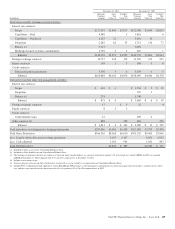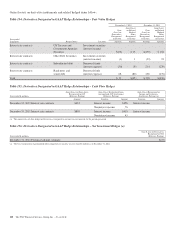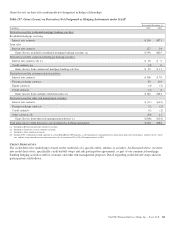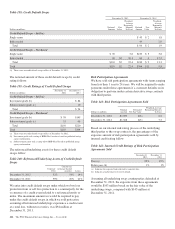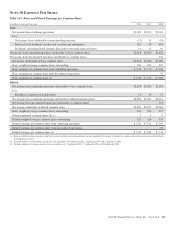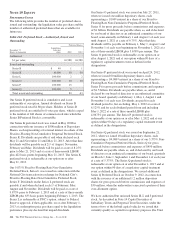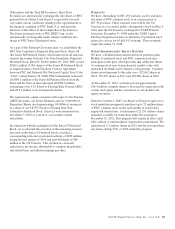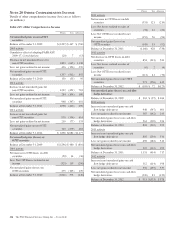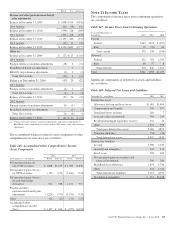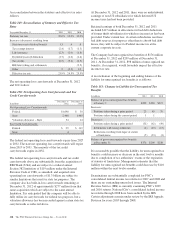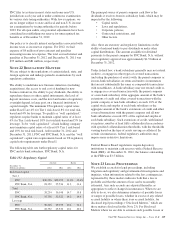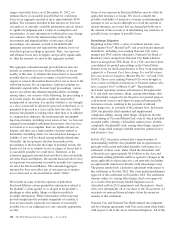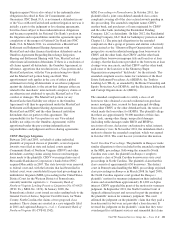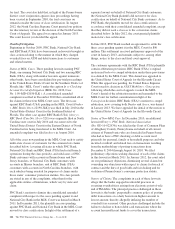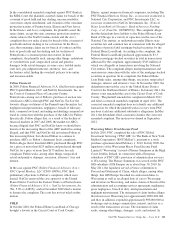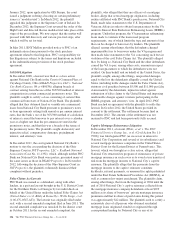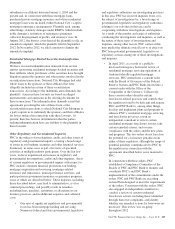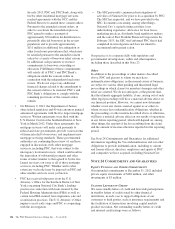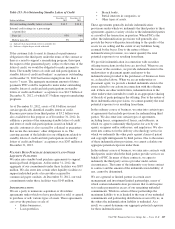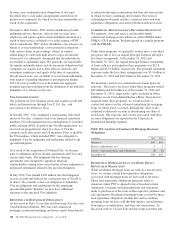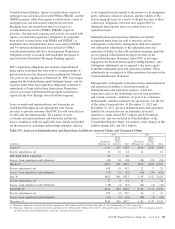PNC Bank 2012 Annual Report Download - page 238
Download and view the complete annual report
Please find page 238 of the 2012 PNC Bank annual report below. You can navigate through the pages in the report by either clicking on the pages listed below, or by using the keyword search tool below to find specific information within the annual report.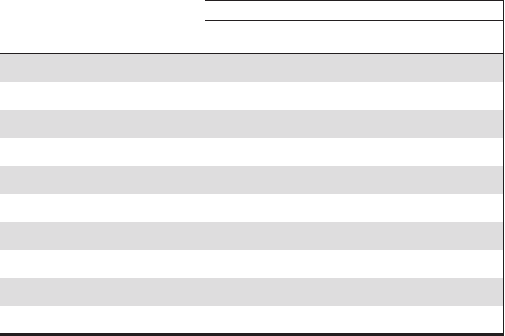
PNC files tax returns in most states and some non-U.S.
jurisdictions each year and is under continuous examination
by various state taxing authorities. With few exceptions, we
are no longer subject to state and local and non-U.S. income
tax examinations by taxing authorities for periods before
2003. For all open audits, any potential adjustments have been
considered in establishing our reserve for unrecognized tax
benefits as of December 31, 2012.
Our policy is to classify interest and penalties associated with
income taxes as income tax expense. For 2012, we had
expense of $4 million of gross interest and penalties
increasing income tax expense. The total accrued interest and
penalties at December 31, 2012 and December 31, 2011 was
$93 million and $81 million, respectively.
N
OTE
22 R
EGULATORY
M
ATTERS
We are subject to the regulations of certain federal, state, and
foreign agencies and undergo periodic examinations by such
regulatory authorities.
The ability to undertake new business initiatives (including
acquisitions), the access to and cost of funding for new
business initiatives, the ability to pay dividends, the ability to
repurchase shares or other capital instruments, the level of
deposit insurance costs, and the level and nature of regulatory
oversight depend, in large part, on a financial institution’s
capital strength. The minimum US regulatory capital ratios
under Basel I are 4% for Tier 1 risk-based, 8% for total risk-
based and 4% for leverage. To qualify as “well capitalized,”
regulators require banks to maintain capital ratios of at least
6% for Tier 1 risk-based, 10% for total risk-based and 5% for
leverage. To be “well capitalized,” a bank holding company
must maintain capital ratios of at least 6% Tier 1 risk-based
and 10% for total risk-based. At December 31, 2012 and
December 31, 2011, PNC and PNC Bank, N.A. met the “well
capitalized” capital ratio requirements based on US regulatory
capital ratio requirements under Basel I.
The following table sets forth regulatory capital ratios for
PNC and its bank subsidiary, PNC Bank, N.A.
Table 152: Regulatory Capital
Amount Ratios
December 31
Dollars in millions 2012 2011 2012 2011
Risk-based capital
Tier 1
PNC $30,226 $29,073 11.6% 12.6%
PNC Bank, N.A. 28,352 25,536 11.3 11.4
Total
PNC 38,234 36,548 14.7 15.8
PNC Bank, N.A. 35,756 32,322 14.2 14.4
Leverage
PNC 30,226 29,073 10.4 11.1
PNC Bank, N.A. 28,352 25,536 10.1 10.0
The principal source of parent company cash flow is the
dividends it receives from its subsidiary bank, which may be
impacted by the following:
• Capital needs,
• Laws and regulations,
• Corporate policies,
• Contractual restrictions, and
• Other factors.
Also, there are statutory and regulatory limitations on the
ability of national banks to pay dividends or make other
capital distributions. The amount available for dividend
payments to the parent company by PNC Bank, N.A. without
prior regulatory approval was approximately $1.5 billion at
December 31, 2012.
Under federal law, a bank subsidiary generally may not extend
credit to, or engage in other types of covered transactions
(including the purchase of assets) with, the parent company or
its non-bank subsidiaries on terms and under circumstances
that are not substantially the same as comparable transactions
with nonaffiliates. A bank subsidiary may not extend credit to,
or engage in a covered transaction with, the parent company
or a non-bank subsidiary if the aggregate amount of the bank’s
extensions of credit and other covered transactions with the
parent company or non-bank subsidiary exceeds 10% of the
capital stock and surplus of such bank subsidiary or the
aggregate amount of the bank’s extensions of credit and other
covered transactions with the parent company and all non-
bank subsidiaries exceeds 20% of the capital and surplus of
such bank subsidiary. Such extensions of credit, with limited
exceptions, must be at least fully collateralized in accordance
with specified collateralization thresholds, with the thresholds
varying based on the type of assets serving as collateral. In
certain circumstances, federal regulatory authorities may
impose more restrictive limitations.
Federal Reserve Board regulations require depository
institutions to maintain cash reserves with a Federal Reserve
Bank (FRB). At December 31, 2012, the balance outstanding
at the FRB was $3.5 billion.
N
OTE
23 L
EGAL
P
ROCEEDINGS
We establish accruals for legal proceedings, including
litigation and regulatory and governmental investigations and
inquiries, when information related to the loss contingencies
represented by those matters indicates both that a loss is
probable and that the amount of loss can be reasonably
estimated. Any such accruals are adjusted thereafter as
appropriate to reflect changed circumstances. When we are
able to do so, we also determine estimates of possible losses
or ranges of possible losses, whether in excess of any related
accrued liability or where there is no accrued liability, for
disclosed legal proceedings (“Disclosed Matters,” which are
those matters disclosed in this Note 23). For Disclosed
Matters where we are able to estimate such possible losses or
The PNC Financial Services Group, Inc. – Form 10-K 219


